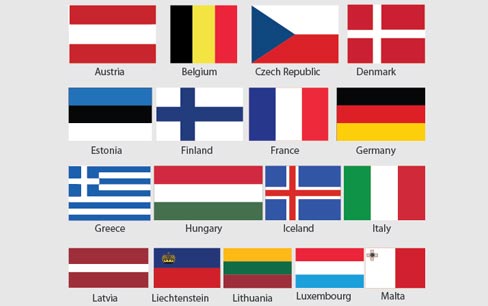ETIAS for Europe Travel

ETIAS stands for the European Travel Information and Authorization System. It was announced by the European Commission in November 2016 and was implemented into legislation in September 2018. The intention of forming the system was to improve the security of EU member states within the Schengen region by capturing data on travelers that currently visit the area without a visa.
The ETIAS will only pre-screen travelers not needing a Schengen Visa. The screening would pertain to terrorism or migration related risks. The objective is to identify individuals who pose security threats before they are able to travel to the Schengen area.
ETIAS is not a visa; it is a visa waiver, similar to the U.S. ESTA and Canadian eTA. Travelers currently visiting European Member countries visa-free will require an ETIAS from 2022 onwards. Passport holders of the EU single market are exempt from ETIAS.
ETIAS Visa Travel Waiver

ETIAS stands for the European Travel Information and Authorization System. It was announced by the European Commission in November 2016 and was implemented into legislation in September 2018. The intention of forming the system was to improve the security of EU member states within the Schengen region by capturing data on travelers that currently visit the area without a visa.
The ETIAS will only pre-screen travelers not needing a Schengen Visa. The screening would pertain to terrorism or migration related risks. The objective is to identify individuals who pose security threats before they are able to travel to the Schengen area.
ETIAS is not a visa; it is a visa waiver, similar to the U.S. ESTA and Canadian eTA. Travelers currently visiting European Member countries visa-free will require an ETIAS from 2022 onwards. Passport holders of the EU single market are exempt from ETIAS.
The application process is aimed at taking approximately 10 minutes or less. The website processing ETIAS applications will support mobile, desktop and mobile devices. The types of information requested include:
- Biometric and personal data such as name, date of birth and gender
- Applicant contant details such as home address email address
- Education history, such as primary, secondary, vocational schooling, university, or no education
- Travel document information, such as a passport or other document, including data such as the document number, issue date, expiry date, and country
- Current occupation or job, including title as well as contact details
- First EU member state of arrival
Travelling The Schengen Zone with ETIAS

Background questions relating to previous criminal activity, drug use, travel to conflict zones, as well as EU and non-EU immigration history.
Third parties may apply on behalf of applicants, yet this must be disclosed at the time of submitting the application. Third parties will also need to provide their name and company information, where relevant, as well as their contact details and relationship to the applicant. More information on the ETIAS application form can be found here: https://etias.com/articles/what-will-be-on-etias-application-form
The ETIAS fee charged on applications for travellers between the ages of 18 and 70 is 7€. There is no ETIAS fee for travellers under the age of 18, or over the age of 70.
Every traveller, regardless of their age, will require an approved ETIAS prior to their arrival to the Schengen area. An ETIAS application is automatically processed based on the following three factors.
Identity – Does the applicant's identity match their passport?
Travel document – Do the travel document details match the information provided by the applicant in other sections? Is it a valid travel document issued by an ETIAS eligible country?
Background questions – Do the answers match the data held in the databases checked by the ETIAS Central Unit?
European Schengen Zone Map
Currently, there are 22 European countries that
form part of the Schengen Area:
- Austria
- Belgium
- Luxembourg
- Netherlands
- Germany
- France
- Spain
- Portugal
- Sweden
- Finland
- Denmark
- Lithuania
- Latvia
- Estonia
- Poland
- Slovakia
- Hungary
- Slovenia
- Italy
- Greece
- Czech Republic
- Malta
Non-EU Member States:
- Iceland
- Liechtenstein
- Norway
- Switzerland
Micro-States de facto part of Schengen Area:
- Monaco
- San Marino
- Vatican City

Visa information System
Each EU member state is a part of the ETIAS National Units. The ETIAS National Units will assess and decide on applications where the ETIAS Central Unit is unable to automatically process an ETIAS application. The ETIAS National Units will need to provide reasons for authorizing or denying applications. Also, the ETIAS National Units can provide opinions and share information amongst member states via their national unit.
Europol is an EU law enforcement agency that deals with organized crime and terrorism amongst EU member states. Europol is responsible for managing the ETIAS watch list, in cooperation with the ETIAS National Units. In the instances where an ETIAS applicant's data matches Europol data during the automated processing stage, the ETIAS National Units will act to assist on determining if the application should be approved, denied, or require additional documentation from the applicant.
Schengen information System
The eu-LISA is an agency that operates large-scale IT systems for the EU. eu-LISTA is responsible for the technical design, development and management of the ETIAS. This entity will also be responsible for maintaining the privacy and security of all applicant data submitted through the digital information systems of the ETIAS.
The ETIAS Screening Board is a collection of representatives from the ETIAS National Units, European Border and Coast Guard Agency and Europol. They decide on the risk indicators to manage the ETIAS watchlist, as well as the management of criteria used for defining, evaluating and revising the risk indicators.
European Border and Coast Guard Agency
The European Border and Coast Guard Agency is an EU agency, that is responsible for the border control of the Schengen Area, The ETIAS Screening Board is a collection of representatives
